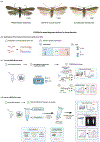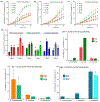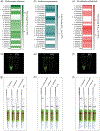CRISPR-based diagnostics detects invasive insect pests
- PMID: 37888995
- PMCID: PMC10842307
- DOI: 10.1111/1755-0998.13881
CRISPR-based diagnostics detects invasive insect pests
Abstract
Rapid identification of organisms is essential for many biological and medical disciplines, from understanding basic ecosystem processes, disease diagnosis, to the detection of invasive pests. CRISPR-based diagnostics offers a novel and rapid alternative to other identification methods and can revolutionize our ability to detect organisms with high accuracy. Here we describe a CRISPR-based diagnostic developed with the universal cytochrome-oxidase 1 gene (CO1). The CO1 gene is the most sequenced gene among Animalia, and therefore our approach can be adopted to detect nearly any animal. We tested the approach on three difficult-to-identify moth species (Keiferia lycopersicella, Phthorimaea absoluta and Scrobipalpa atriplicella) that are major invasive pests globally. We designed an assay that combines recombinase polymerase amplification (RPA) with CRISPR for signal generation. Our approach has a much higher sensitivity than real-time PCR assays and achieved 100% accuracy for identification of all three species, with a detection limit of up to 120 fM for P. absoluta and 400 fM for the other two species. Our approach does not require a sophisticated laboratory, reduces the risk of cross-contamination, and can be completed in less than 1 h. This work serves as a proof of concept that has the potential to revolutionize animal detection and monitoring.
Keywords: Keiferia lycopersicella; Phthorimaea absoluta; Scrobipalpa atriplicella; Tuta absoluta; CRISPR; Cas12a; RPA; diagnostics; genetic identification; leaf miner.
© 2023 John Wiley & Sons Ltd.
Conflict of interest statement
CONFLICT OF INTEREST STATEMENT
The authors declare no competing interests.
Figures





Update of
-
CRISPR-based diagnostics detects invasive insect pests.bioRxiv [Preprint]. 2023 May 18:2023.05.16.541004. doi: 10.1101/2023.05.16.541004. bioRxiv. 2023. Update in: Mol Ecol Resour. 2024 Jan;24(1):e13881. doi: 10.1111/1755-0998.13881. PMID: 37292907 Free PMC article. Updated. Preprint.
References
MeSH terms
Substances
Grants and funding
LinkOut - more resources
Full Text Sources
Research Materials

